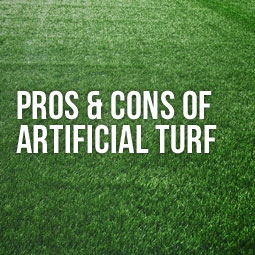The Pros and Cons of Artificial Turf
Pros And Cons Of Artificial Turf is a great option for sports fields and residential lawns. It requires less upkeep than natural grass and looks beautiful all year round.
It also reduces irrigation needs, which benefits environmental aquifers and watersheds. And it eliminates air pollution from gas-powered equipment and fertilizers.

First-generation synthetic turf gained a bad reputation as unforgiving, resulting in more injuries than would be the case on grass. Modern systems with longer fibers and sand or crumb rubber infill are safer for players.
- It’s Expensive
Artificial turf costs a lot upfront. It requires the installation of a weed barrier, base material, and sand or gravel to level the area, then adding turf and infill. The infill can be sand, stone, or recycled crumb rubber, and each has its price tag. Crumb rubber infill is typically the more expensive. The cost of the turf also varies depending on its blade shape, with straight-blade styles being less costly because they require less manufacturing complexity.
Artificial grass requires very little water to maintain and is much more durable than natural grass. It can withstand heavy use and weather conditions without losing texture, color, or consistency. This makes it an ideal option for sports fields, where the surface can withstand repeated contact from athletes’ cleats and still look beautiful.
However, it’s important to remember that synthetic turf can get hot and uncomfortable under the sun. Some types of synthetic turf can even emit odors, especially if urine is not cleaned up properly. To avoid a pungent odor buildup, it’s crucial to allow solid waste to dry before removing it and to rinse the turf regularly.
It’s also important to note that artificial turf can be more expensive than a natural lawn in the long run. Unlike a natural lawn, which is regenerative and pumps out oxygen, artificial turf cannot replenish itself, so it needs to be replaced over time. This can add up quickly and may not fit all households well. Also, homeowners are often fined or ordered to remove their artificial lawns under local bylaws that seek to preserve and protect natural landscapes and gardens.
- It’s Not Easy to Maintain
Artificial turf has many advantages, but it’s not without disadvantages. It is more difficult to maintain than natural grass. A lot of time and money is spent on watering, cutting, and fertilizing natural lawns, but synthetic grass eliminates these steps. It is nearly maintenance-free since it doesn’t require mowing or watering, but it still requires regular sweeps to keep the turf clean. Sometimes, pesky weeds will pop up, but this can be easily solved with a good weed killer and a power broom.
Stains are a common problem with synthetic grass, and while they can be cleaned up just like normal grass, they tend to set if not treated promptly. This makes the stain more difficult to remove and, in some instances, can cause long-term damage. It is also prone to odors, and some types of infill have been found to hold toxins, which can be toxic to families and pets.
Turf tears are a common problem, and many things can cause them. Improper installation is one of the leading causes and can create dips, bumps, and snags in the surface, increasing the likelihood of tearing or ripping. Frequent foot traffic, wheels, or dragging objects on the surface can also cause rips, tears, and changes in weather. It’s important to remember these when considering an upgrade to your yard with synthetic grass.
- It’s Not Easy to Clean
Artificial turf is a good landscaping choice, but it can also be difficult to keep clean. You’ll need to maintain a regular schedule of rinsing, raking, and spot-cleaning any stains. Depending on how frequently you use the lawn, some areas may need more maintenance than others. Ideally, you should clean the artificial grass every week. For best results, rake the soil underneath the synthetic turf and use a de-compacter before putting the infill back on top.
Many people who use artificial grass have exchanged high water costs, allergens, and hours spent sweating during the summer grooming real grass for a green lawn that saves money, energy, and time. However, while synthetic turf is easier to maintain than a natural yard, it still requires care and attention.
Proper maintenance can ensure that the synthetic grass lasts for about 15 to 25 years, and it helps prevent the need to spend money on costly replacements. It can also reduce the risk of injuries in sports and make it safer for kids to play outside.
Homeowners’ most common issues with artificial turf include odor, fungus, and mold. You can use a mild cleaner with water to remove these stains. If the stains persist, you can purchase mineral spirits or petroleum-based solvents from a carpet-cleaning supply supplier. If the stains are caused by tree sap, you can use dry ice to freeze and scrape it off. You can apply 1% hydrogen peroxide with a soft sponge to the turf’s surface for fungus and mold that won’t respond to commercial cleaners. It would be best to discuss tougher stains with a professional before using harsh chemicals on the synthetic lawn.
- It’s Not Easy to Repair
Artificial turf is designed to be a low-maintenance landscaping solution, but it’s not immune from some issues. Like any surface exposed to humans, pets, and the elements, it can suffer damage over time. Thankfully, most of these issues are easy to fix.
The most common synthetic turf problems are weeds, which can pop up between the infill and along the edges of the lawn. Just as with a natural yard, these weeds will need to be pulled or sprayed to curb their growth. Some people may also notice mildew on their turf, which can be treated with a household cleaner or vinegar.
It’s common for turf to get hot on sunny days, leading to abrasions and burns. A quick hose down with cool water will help lower the surface temperature, and certain types of infill are designed to stay cooler than rubber crumbs.
Another issue is odor buildup, which pet and bird droppings, urine, blood, sweat, and other liquids can cause. Just as with natural grass, if these substances are left to rot on the turf, they can cause a stench that can be difficult to eliminate.
As a general rule, it’s best to keep any leftover pieces of turf that are initially fitted during the installation process so that they can be used to patch up any damaged areas down the road. For more extensive damage, however, professional assistance will likely be needed to ensure that the new section of turf is glued down properly and blends in with the existing area seamlessly. The good news is that these repairs are often much cheaper than a full turf replacement.
- It’s Not Easy to Clean
Synthetic grass’s convenience and low maintenance costs often overshadow the fact that keeping clean is not easy. Food and drink spills, gum spit, pet waste, and other messes can be difficult to remove from turf without leaving a sticky residue. If left unattended, these substances can even attract pests and create a smell that is hard to get rid of.
This mess can also become a breeding ground for harmful bacteria, especially if the infill is made from crumb rubber. People used to worry that toxins from this infill would leach into water run-off and harm children, pets, and the environment. However, studies have shown that this is fine with modern artificial turf.
While synthetic turf has many benefits, it is important to research different brands and types before choosing what will work best for your property. A reputable company that offers superior products backed by a generous warranty will provide peace of mind that your investment is protected should something go wrong.
Synthetic turf holds up well under heavy foot traffic and is resistant to extreme weather conditions, including scorching sun, downpours, and freeze/thaw cycles. It’s also durable enough to withstand the pounding of children’s playground equipment and sports activities. It doesn’t develop ruts or worn paths like natural lawns and is less likely to be damaged by dogs digging or clawing at it.
If you want to give your yard a fresh new look without spending hours sweating over a mower or spending money on expensive chemicals, consider working with a professional landscaping company. US Turf experts can create a custom plan for your backyard that will reduce your carbon footprint, save you time and money, and make your yard look amazing.




